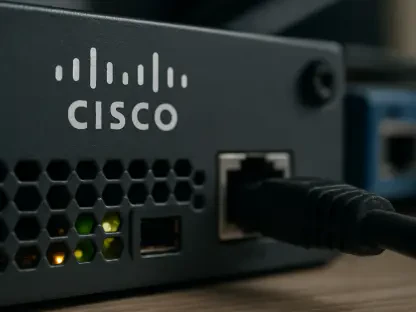The shift to hybrid and multi-cloud models has revolutionized organizational IT infrastructure but not without introducing complex security concerns. As companies navigate their digital transition, safeguarding their IT environments has become a multifaceted challenge due to the increased intricacy. Protecting data across diverse platforms and services further complicates security measures. Managed cloud security services are emerging as a significant countermeasure, offering to alleviate the burden on organizations. These services provide expert oversight and continuous security management, tailored to the nuanced demands of modern cloud setups. With cyber threats evolving, the question remains whether such managed services are capable of delivering robust security to meet the dynamic landscape of cloud infrastructure. As companies weigh their options, the effectiveness of managed cloud security solutions stands as a critical consideration in ensuring a secure, seamless digital transformation.
Assessing Cloud Security Challenges
The Uniqueness of Cloud Security Concerns
Migrating to the cloud introduces a new spectrum of security challenges for organizations. In the push to rapidly deploy cloud-based applications, security may be compromised as shortcuts in development are taken. Prefabricated software can reduce time to market but often lacks the necessary safeguards for cloud environments, opening doors to security vulnerabilities.The unique complexities of cloud security demand specialized attention. Practices tailored to cloud security are imperative to protect sensitive information and ensure regulatory compliance. Building an IT infrastructure with a cloud-first approach, companies must prioritize these practices to avoid jeopardizing their data assets. This shift stresses the importance of integrating robust security measures within cloud applications from the outset rather than as an afterthought. Securing operations in the cloud requires a clear understanding of the potential risks and a proactive stance in addressing them with appropriate, cloud-native security solutions.
Tool Sprawl and the Shared Responsibility Model
In the cybersecurity landscape, one major issue is the excess of security tools that teams must manage. This proliferation of tools, known as tool sprawl, complicates clear oversight within IT frameworks. The shared responsibility model exacerbates this complexity. Common in cloud computing, this model delineates that while providers secure the underlying infrastructure, customers must protect their data. Unfortunately, this division of duty is frequently misunderstood, creating vulnerabilities that attackers can exploit. It’s crucial for organizations to comprehend their specific security responsibilities under this model to maintain robust defense mechanisms. A proper understanding ensures the integrity of their data and systems and prevents security lapses that could lead to potential breaches. As cloud services continue to grow, delineating and understanding these roles will be paramount for organizations to establish a comprehensive security posture that withstands evolving threats.
Managed Cloud Security Services: Merits and Demerits
The Promise of Managed Cloud Security Services
Managed cloud security services offer a solution to the complexity of today’s cloud infrastructures by utilizing advanced threat intelligence to rapidly detect and respond to cybersecurity issues. Such services not only prioritize and streamline alerts to enhance security operations but also provide the expertise needed to supplement in-house capabilities, ensuring a robust defense against digital threats. With these services, businesses gain the ability to bolster their security effectively without the need to proportionally expand their internal teams or resources. This brings a level of efficiency and specialized knowledge to operations, presenting organizations with a nuanced approach to their cybersecurity challenges. Managed services act as a force multiplier, providing the tools and intelligence necessary to keep pace with an ever-evolving threat landscape, thus enabling businesses to focus on their core objectives while maintaining a secure cloud environment.
Navigating the Limitations
While managed services offer numerous advantages, integrating them into a company’s existing security infrastructure can be complicated. These services must work seamlessly with a range of established cybersecurity protocols. One potential issue is that managed security providers could unintentionally introduce new security weaknesses if a managed service doesn’t align with existing security policies or isn’t configured correctly, it could create gaps in an organization’s defenses. Furthermore, reliance on external providers for security management might lead to a diminished internal focus on security practices. Additionally, the exchange of sensitive information with third-party providers could raise data privacy concerns. Despite these challenges, the benefits of managed services, such as cost-effectiveness and access to specialized expertise, often outweigh the risks. However, organizations need to conduct thorough due diligence and maintain robust oversight to ensure the security and integrity of their systems when engaging with managed services providers.
The Procurement and Integration of Cloud Security
Suitability for Different Organization Sizes
Managed security services are a boon for small and medium-sized enterprises (SMEs) that often grapple with limited resources. By outsourcing cyber protection to experts, these smaller businesses can create a robust security infrastructure that levels the playing field with larger companies. Such services enable SMEs to tap into advanced security measures that would typically be financially or operationally out of reach. This accessibility to high-end security resources helps to safeguard against cyber threats more effectively and efficiently, giving businesses peace of mind and allowing them to focus on their core operations. Outsourced security solutions thus act as a powerful equalizer in the digital realm, ensuring SMEs can defend themselves amidst a landscape of ever-evolving cyber risks without bearing the full cost and complexity of developing in-house security capabilities.
Selecting the Right Managed Security Partner
When choosing a managed cloud security service provider, it’s crucial for businesses to weigh trustworthiness against the provider’s proven capabilities. Companies need to seek out providers with reputable, consistent success in cloud security, corroborated by solid endorsements from customers and partnerships with reputable cloud vendors. The selected provider should offer a solution that fits organically into the company’s existing security framework, augmenting its defense mechanisms rather than introducing unnecessary complexity. This requires a strategic alignment where the provider’s tools and services not only meet the organization’s security requirements but also contribute to a simplified and strengthened security posture. Agencies should opt for a service that assures minimal friction and aligns with the strategic direction of their IT security landscape to ensure a fortified, well-integrated cloud defense.
Embracing Holistic Cloud Security Approaches
Beyond Simple Tool Selection
Optimizing cloud security isn’t just about accumulating security tools; it’s about weaving them into an integrated framework that envelops all of a company’s IT systems. When seeking managed cloud security services, companies should aim for solutions that not only fit with but elevate their current security setups. The objective transcends mere accumulation of tools; it seeks harmony in the security processes, thereby bolstering the enterprise’s defense mechanisms. This holistic approach hinges on strategic integration, ensuring each tool functions in concert with others, thus enhancing the security fabric of an organization. Such a strategy is critical in creating a robust, responsive security posture capable of addressing the complex challenges presented by an ever-evolving threat landscape. The integration of managed services should, therefore, be meticulously planned, with an emphasis on synergy and the fortification of the organization’s security architecture.
The Role of Unified Security Stances
The evolving landscape of enterprise IT demands a consolidated security approach, and Extended Detection and Response (XDR) systems stand at the forefront of this integration. XDR unifies disparate security measures into a cohesive defense strategy, significantly enhancing the ability to detect and respond to threats. When combined with managed cloud security services, XDR becomes a critical component in developing a robust security framework that spans the entirety of an organization’s IT infrastructure. This synergy ensures not only higher visibility across all domains but also establishes a more controlled and secure environment capable of withstanding the complexities of modern cybersecurity challenges. Securing an enterprise against a spectrum of cyber threats hinges on implementing such comprehensive solutions, which tie together the strengths of XDR and cloud security services to protect assets in an increasingly interconnected and threat-prone digital ecosystem.









